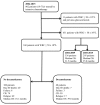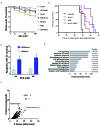Dexamethasone in hyperleukocytic acute myeloid leukemia
- PMID: 29519869
- PMCID: PMC6058767
- DOI: 10.3324/haematol.2017.184267
Dexamethasone in hyperleukocytic acute myeloid leukemia
Abstract
Patients with acute myeloid leukemia and a high white blood cell count are at increased risk of early death and relapse. Because mediators of inflammation contribute to leukostasis and chemoresistance, dexamethasone added to chemotherapy could improve outcomes. This retrospective study evaluated the impact of adding or not adding dexamethasone to chemotherapy in a cohort of 160 patients with at least 50×109 white blood cells. In silico studies, primary samples, leukemic cell lines, and xenograft mouse models were used to explore the antileukemic activity of dexamethasone. There was no difference with respect to induction death rate, response, and infections between the 60 patients in the dexamethasone group and the 100 patients in the no dexamethasone group. Multivariate analysis showed that dexamethasone was significantly associated with improved relapse incidence (adjusted sub-HR: 0.30; 95% CI: 0.14-0.62; P=0.001), disease-free survival (adjusted HR: 0.50; 95% CI: 0.29-0.84; P=0.010), event-free survival (adjusted HR: 0.35; 95% CI: 0.21-0.58; P<0.001), and overall survival (adjusted HR: 0.41; 95% CI: 0.22-0.79; P=0.007). In a co-culture system, dexamethasone reduced the frequency of leukemic long-term culture initiating cells by 38% and enhanced the cytotoxicity of doxorubicin and cytarabine. In a patient-derived xenograft model treated with cytarabine, chemoresistant cells were enriched in genes of the inflammatory response modulated by dexamethasone. Dexamethasone also demonstrated antileukemic activity in NPM1-mutated samples. Dexamethasone may improve the outcome of acute myeloid leukemia patients receiving intensive chemotherapy. This effect could be due to the modulation of inflammatory chemoresistance pathways and to a specific activity in acute myeloid leukemia with NPM1 mutation.
Copyright © 2018 Ferrata Storti Foundation.
Figures




References
-
- Dohner H, Weisdorf DJ, Bloomfield CD. Acute myeloid leukemia. N Engl J Med. 2015;373(12):1136–1152. - PubMed
-
- Rollig C, Ehninger G. How I treat hyperleukocytosis in acute myeloid leukemia. Blood. 2015;125(21):3246–3252. - PubMed
-
- Kelaidi C, Chevret S, De Botton S, et al. Improved outcome of acute promyelocytic leukemia with high WBC counts over the last 15 years: the European APL Group experience. J Clin Oncol. 2009;27(16):2668–2676. - PubMed
-
- Sanz MA, Montesinos P. How we prevent and treat differentiation syndrome in patients with acute promyelocytic leukemia. Blood. 2014;123(18):2777–2782. - PubMed
Publication types
MeSH terms
Substances
LinkOut - more resources
Full Text Sources
Other Literature Sources
Medical

